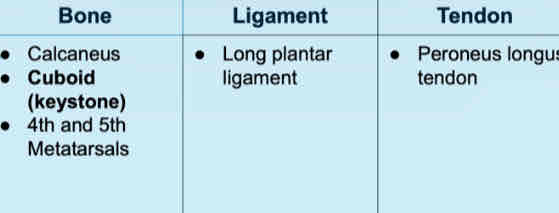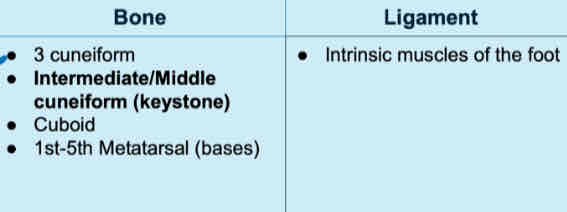ANATOMY OF THE LEG, ANKLE, AND FOOT
1/67
There's no tags or description
Looks like no tags are added yet.
Name | Mastery | Learn | Test | Matching | Spaced |
|---|
No study sessions yet.
68 Terms
TIBIA
Medial bone of the leg
“Shin bone”
90% weight-bearing
Medial malleolus
FIBULA
Lateral bone of the leg
Essentially considered as a non weight bearing bone (Brunnstrom)
10% weight-bearing (Brunnstrom)
It takes no part in the transmission of body weight (Snell)
Carries 17% of the axial load (Magee)
Lateral malleolus
Calcaneus
Talus
2 bones of the hindfoot?
Navicular
Cuboid
Medial Cuneiform
Lateral Cuneiform
Intermediate Cuneiform
5 bones of the midfoot?
Phalanges
Metatarsals
What forms the forefoot?
FICK ANGLE
The foot assumes a slight toe-out position
Fick angle is approximately 12° to 18° from the sagittal axis of the body, developing from 5° in children
The fick angle is approximately __° to __° from the sagittal axis of the body, developing from __° in children
Index plus type; egyptian type foot
_______: The first metatarsal (1) is longer than the second (2), with the others (3, 4, and 5) of progressively decreasing lengths, so that 1 > 2 > 3 > 4 > 5. This can result in an ____ type foot
Index plus-minus type; squared type foot
_________: The first metatarsal is equal in length to the second metatarsal, with the others progressively diminishing in length, so that 1 = 2 > 3 > 4 > 5. This results in a ______ type foot
Index minus type; morton’s or greek type foot
_________: The second metatarsal is longer than the first and third metatarsals. The fourth and fifth metatarsals are progressively shorter than the third, so that 1 < 2 > 3 > 4 > 5. This results in a ______ type foot
DISTAL TIBIOFIBULAR JOINT
Between the fibular notch at the lower end of tibia and the lower end of the fibula.
Fibrous joint
No capsule
Interosseous ligament
Anterior tibiofibular ligament
Posterior tibiofibular ligament
Inferior transverse ligament
Ligaments under DISTAL TIBIOFIBULAR JOINT?
Plantar flexion
Resting position of TIBIOFIBULAR JOINT?
Maximum dorsiflexion
Close packed position of TIBIOFIBULAR JOINT?
Pain when joint is stressed
Capsular pattern of TIBIOFIBULAR JOINT?
TALOCRURAL JOINT
“Ankle joint” = Ankle mortise and talus
Uniaxial
Modified hinge joint
Synovial joint
1 DOF
Dorsiflexion and Plantarflexion
Actions under TALOCRURAL JOINT?
Deltoid (medial collateral) ligaments (4)
Lateral collateral ligaments (3)
Ligaments under TALOCRURAL JOINT?
10 degrees plantar flexion, midway between inversion and eversion
Resting position of TALOCRURAL JOINT?
Maximum dorsiflexion
Close packed position of TALOCRURAL JOINT?
Plantar flexion, dorsiflexion
Capsular pattern of TALOCRURAL JOINT?
SUBTALAR JOINT
Synovial joint
3 DOF: gliding and rotation
Lateral talocalcaneal ligament
Medial talocalcaneal ligament
Interosseous talocalcaneal ligament
Cervical ligament
Ligaments under SUBTALAR JOINT?
Midway between extremes of range of motion
Resting position of SUBTALAR JOINT?
Supination
Close pack position of SUBTALAR JOINT?
Limited ROM (Varus, Valgus)
Capsular pattern of SUBTALAR JOINT?
DISTAL TIBIOFIBULAR JOINT
TALOCRURAL JOINT
SUBTALAR JOINT
3 JOINTS OF HINDFOOT?
CHOPART JOINT
“Transverse tarsal joints”
“Midtarsal joints”
Refers collectively to the midtarsal joints between the:
Talus-calcaneus
Navicular-cuboid
TALOCANEONAVICULAR JOINT
Ball and socket joint
Synovial joint
3 DOF: gliding and rotation
Dorsal talonavicular ligament
Bifurcated ligament
Plantar Calcaneonavicular (spring) ligament
3 ligaments under TALOCANEONAVICULAR JOINT?
CUNEONAVICULAR JOINT
Plane synovial joint
Allows slight gliding and rotation
CUBOIDEONAVICULAR JOINT
Fibrous joint
Allows slight gliding and rotation
INTERCUNEIFORM JOINT
Plane synovial joints
Slight gliding and rotation
CUNEOCUBOID JOINT
Plane synovial joints
Slight gliding and rotation
CALCANEOCUBOID JOINT
Saddle shape joint
Allows gliding with conjunct rotation
Bifurcated ligaments
Calcaneocuboid ligament
Long plantar ligaments
Ligaments under CALCANEOCUBOID JOINT?
Midway between extremes of range of motion
Resting position of MIDTARSAL JOINTS?
Supination
Close packed position of MIDTARSAL JOINTS?
Dorsiflexion, plantar flexion, adduction, medial rotation
Capsular pattern of MIDTARSAL JOINTS?
TARSOMETATARSAL JOINT
Taken together, these joints are referred to as “Lisfranc joint”
Plane synovial joint
INTERMETATARSAL JOINTS
4 intermetatarsal joints
Plane synovial joint
Allows gliding
METATARSOPHALANGEAL JOINTS
5 metatarsophalangeal joints
Condyloid joints
2 DOF
Flexion, extension, abduction and adduction
Midway between extremes of range of motion
Resting position of TARSOMETATARSAL JOINTS?
Supination
Close packed position of TARSOMETATARSAL JOINTS?
None
Capsular pattern of TARSOMETATARSAL JOINTS?
INTERPHALANGEAL JOINTS
Synovial hinge joint
1 DOF
Flexion and extension
Tibionavicular ligament
Tibiocalcaneal ligament
Posterior tibiotalar ligament
DELTOID (Medial Collateral) LIGAMENT
What are the 3 Superficial (Resist Talar Abduction) ligaments?
10 degrees of extension
Resting position of METATARSOPHALANGEAL JOINTS?
Full exension
Close packed position of METATARSOPHALANGEAL JOINTS?
Big toe: extension, flexion
Second to fifth toe: variable
Capsular pattern of METATARSOPHALANGEAL JOINTS?
Deep
Anterior tibiotalar ligament
Resists:
Lateral translation of the talus
Lateral rotation of the talus
DELTOID (Medial Collateral) LIGAMENT
What is the deep ligament and what does it resist?
Slight flexion
Resting position of INTERPHALANGEAL JOINTS?
Full extension
Close packed position of INTERPHALANGEAL JOINTS?
Flexion, extension
Capsular pattern of INTERPHALANGEAL JOINTS?
Anterior talofibular ligament
LATERAL COLLATERAL LIGAMENT
Resists inversion of talus
MC injured (lateral ankle sprain)
Posterior talofibular ligament
LATERAL COLLATERAL LIGAMENT
Resists ankle DF, adduction (tilt), medial rotation and medial translation of the talus
Calcaneofibular ligament
LATERAL COLLATERAL LIGAMENT
Resists maximum inversion at the ankle and subtalar joints.
2nd MC injured (lateral ankle sprain)
PLANTAR APONEUROSIS
“Plantar fascia”
It begins posteriorly on the medial tubercle of the calcaneus and continues anteriorly to attach by digitations to the plantar plates and then, via the plates, to the proximal phalanx of each toe.
MEDIAL LONGITUDINAL ARCH

LATERAL LONGITUDINAL ARCH

TRANSVERSE ARCH

1.2 times the body weight
FOOT LOADING DURING GAIT
During walking?
2 times the body weight
FOOT LOADING DURING GAIT
During running?
5 times the body weight
FOOT LOADING DURING GAIT
During jumping (from height of 60cm [2feet])?
ANKLE SPRAIN
A sprained ankle is nearly always an inversion injury, involving twisting of the weight-bearing plantar flexed foot.
The person steps on an uneven surface and the foot is forcibly inverted or lands on an inverted foot from a vertical jump.
Lateral ligament sprains occur in running and jumping sports, particularly basketball (70–80% of players have had at least one sprained ankle).
The lateral ligament is injured because it is much weaker than the medial ligament and is the ligament that resists inversion at the talocrural joint.
The anterior talofibular ligament—part of the lateral ligament—is most vulnerable and most commonly torn during ankle sprains, either partially or completely, resulting in instability of the ankle joint.
PLANTAR FASCIITIS
Inflammation of the plantar fascia
Often caused by an overuse mechanism
It may result from running and high-impact aerobics, especially when inappropriate footwear is worn.
It causes pain on the plantar surface of the foot and heel.
The pain is often most severe after sitting and when beginning to walk in the morning.
ASTRAGALUS
Other name for talus?